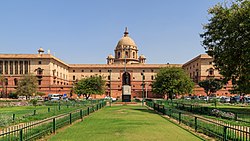Top Qs
Timeline
Chat
Perspective
Ministry of External Affairs (India)
Government ministry of India From Wikipedia, the free encyclopedia
Remove ads
The Ministry of External Affairs (abbreviated as MEA; ISO: Vidēśa Mantrālaya[a]) is India's foreign ministry. The ministry is tasked with formulating and implementing India's foreign policy and representing India on the global stage. The Ministry is headed by the Minister of External Affairs, a member of the Prime Minister's Cabinet. The Minister is typically assisted by one or more junior ministers, known as Ministers of State (MoS) for External Affairs. The Foreign Secretary of the Republic of India is the senior-most non-elected official and the administrative head of the ministry.
It has been suggested that Minister of State for External Affairs (India) be merged into this article. (Discuss) Proposed since February 2025. |
The Ministry of External Affairs operates more than 200 diplomatic missions around the world through which it represents the Government of India on the international stage. In addition, the Ministry is responsible for India's representation at the United Nations and other international organizations. The Ministry is also responsible for the repatriation of Indian citizens in danger abroad and in the extradition of fugitives who have fled India. The Ministry of External Affairs may also advise other ministries and state governments in their interactions with foreign entities and brief them on pertinent international developments.
The Parliamentary Standing Committee on External Affairs, consisting of elected members from both the Lok Sabha and the Rajya Sabha, is tasked with this ministry's legislative oversight.
Remove ads
History
Summarize
Perspective
The Ministry was initially the Ministry of External Affairs and Commonwealth Relations, a holdover from the British Raj. It was renamed the Ministry of External Affairs in 1948.[4] Prime Minister Jawaharlal Nehru held the portfolio as an additional charge till his death in 1964 and it was only then that a separate Minister with Cabinet rank was appointed. The ministry is responsible for the administration of Naga Hills, Tuensang Area, the Emigration Act of 1983, the Reciprocity Act of 1943, the Port Haj Committee Act of 1932, the Indian Merchant Shipping Act in so far as it relates to pilgrim ships, the Indian Pilgrim Shipping Rules of 1933, the Protection of Pilgrims Act of 1887 (Bombay) and the Protection of the Mohammedan Pilgrims Act of 1896 (Bengal).
The Ministry was integrated with Ministry of Overseas Indian Affairs on 7 January 2016.[5] The government said that the decision was taken in line with government's "overall objective of minimizing government and maximizing governance" and that it will help the government address duplication as well as unnecessary delays.[6]
The Ministry is the cadre-controlling authority of the Indian Foreign Service; the service is wholly under the administration and supervision of the External Affairs Ministry.
Remove ads
Organizational structure
The Ministry of External Affairs is headed by the Minister of External Affairs (or simply, the Foreign Minister; in Hindi: Videsh Mantri).The Foreign Secretary is the most senior civil servant who is the head of the Department of Foreign Affairs,[7] and is supported by other secretary level officers.
- Foreign Secretary — Vikram Misri
- Secretary (West) — Tanmaya Lal
- Secretary (East) — Periasamy Kumaran
- Secretary (Economic Relations) — Dammu Ravi[8][9]
- Secretary (Consular, Passport, Visa and Overseas Indian Affairs) — Arun Kumar Chatterjee
- Secretary (South) — Neena Malhotra
- Official Spokesperson and Additional Secretary (External Publicity) — Randhir Jaiswal
Remove ads
Development Partnership Administration
Development Partnership Administration (DPA) is an agency under the Ministry of External Affairs formed in 2013 to increase its strategic footprint and for the effective execution of projects with professionals from diverse backgrounds. India has an elaborate project portfolio in its neighbourhood, including Bhutan, Nepal, Afghanistan, Maldives, Sri Lanka, and Bangladesh, as well as Africa and Latin America. It is headed by Sujata Mehta, one of India's foremost diplomats and former Indian representative to the UN Conference on Disarmament, Geneva. Mehta is Special Secretary in the MEA.[10][11] According to OECD estimates, 2019 official development assistance from India increased to US$1.6 billion.[12]
India Perspectives
India Perspectives[13] is the flagship publication of the Ministry of External Affairs. A bi-monthly magazine, it is digitally published in English and Hindi, and 14 other international languages, with a readership spanning 170 countries. It is crafted to support the Ministry's diplomatic initiatives and highlight India's bilateral ties with the rest of the world.
The magazine provides an insight into India's culture and tradition along with elements of contemporary India. With intelligent, analytical and verified editorial content, the publication is one of the most authentic sources of information regarding India's ‘soft diplomacy’ initiatives as well as its rich cultural, scientific and political heritage. By showcasing the country's various facets through original stories on travel, art, music, cinema and more, the magazine takes India to the world.
Remove ads
Location
The office of the Ministry is located in the South Block building which also contains the Prime Minister's office and Ministry of Defence. Other offices are located in Jawaharlal Nehru Bhawan, Shastri Bhawan, Patiala House, and ISIL Building.[14]
Parliamentary Standing Committee
Parliamentary Standing Committee on External Affairs is mandated with the task of the legislative oversight of the Ministry of External Affairs.[15]
Under Strength
In March 2023, the committee in its Demand for Grants (2023–24) report, criticized the ministry for being "most short-staffed" and under-budgeted. The committee highlighted that The total strength of 4,888 is distributed across different cadres of the Ministry such as the Indian Foreign Service (IFS), IFS General Cadre, IFS Group B, Stenographers Cadre, Interpreters Cadre, Legal and Treaties Cadre, among others. The cadre strength of Indian Foreign Service Officers is only 1,011, just 22.5 percent of the total strength. Out of IFS 'A' cadre, 667 are posted at the Missions abroad and 334 are manning the headquarters in Delhi, which currently has 57 divisions.[16] The committee also highlighted that the ministry “remains one amongst the least funded central ministries” as its actual annual spending has been around 0.4% of the total budgetary allocation of the government since 2020–21.[1]
Remove ads
List of operations by the Ministry of External Affairs (India)
Summarize
Perspective
This is a list of major operations carried out by the Ministry of External Affairs (India).
Remove ads
See also
Notes
References
External links
Wikiwand - on
Seamless Wikipedia browsing. On steroids.
Remove ads


